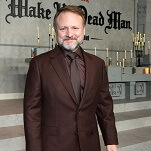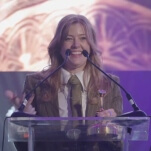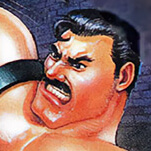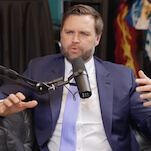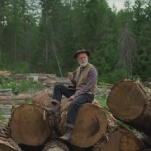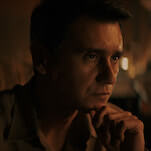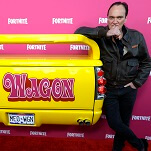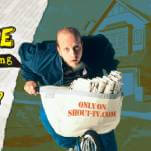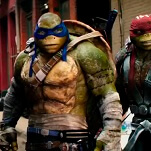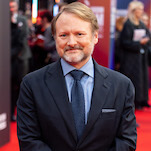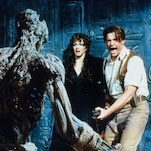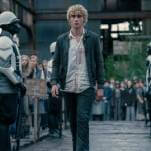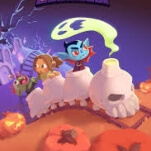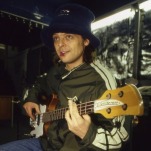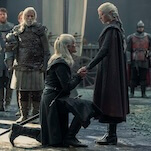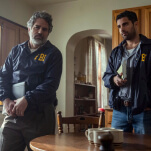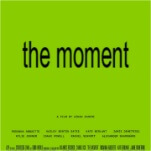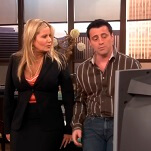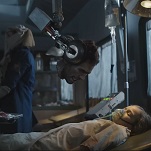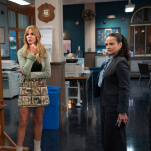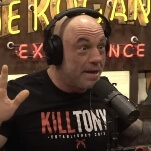Opening shots don’t come much more iconic or influential than Touch Of Evil’s unbroken three-minute journey through the streets of a Mexican border town, in the company of a ticking bomb. Indeed, it’s the only shot I can think of that’s inspired multiple nesting self-referential homages, creating a cinematic Russian doll over a period of decades. Robert Altman’s The Player kicks off with a similarly complex tour of a Hollywood studio’s parking lot, and over the course of its eight minutes it repeatedly picks up a security guy (Fred Ward) who rhapsodizes about lengthy tracking shots, specifically citing Touch Of Evil—though he falsely claims that it runs six-and-a-half minutes, amending that to “well, three or four, anyway” when challenged. And a few years ago, a little-seen (but terrific) Japanese movie, Who’s Camus Anyway?, began with its own seven-minute, single-shot tour de force, roving all over a college campus while a pair of nerdy film students discuss the opening of both Touch Of Evil (getting the duration right this time) and The Player (which one of them falsely claims is really two shots stitched together), along with that of another Japanese film called Shonben Rider, which I’ve never seen. It’s the no-cut hall of mirrors.
Those of you familiar with my controversial piece on Children of Men may be concerned that I’m here to argue that such shots should be outlawed. Fear not—I love all three. My beef isn’t with long, technically complex shots per se; it’s with shots that (to my mind) eschew editing merely in order to show off. (Possibly the biggest offender in that regard is Brian De Palma’s Snake Eyes, though at least he’s having a lot of fun with it.) In The Player and Who’s Camus Anyway?, the absence of cuts is one big formal meta-joke, which is why characters deliberately call attention to it by discussing the history of the very shot they inhabit. And Touch Of Evil’s opening shot belongs in a category by itself. Orson Welles isn’t showboating here, by any means—he has sound reasons for constructing the sequence the way he does, and arguably passes up several opportunities to make it flashier or more technically impressive. It’s essentially a long, elaborate tease, very much indebted to Hitchcock’s notions about the nature of suspense. Take a look.
As you may be aware, this isn’t the same version of the shot that played in theaters back in 1958. Touch Of Evil was taken away from Welles by Universal and more or less butchered; the DVD that’s now available features a painstaking reconstruction derived from a 58-page memo Welles wrote to the studio after seeing their cut, detailing changes he hoped they would make. Originally, the film’s opening credits played over the shot, accompanied by Henry Mancini’s Latin-inflected score. Am I a bad cinephile if I confess that I kinda miss that version? (I’d point you to it, but it doesn’t seem to be available anywhere online, surprisingly.) Welles’ musical concept, in which we hear various competing juke-joint bands being piped onto the street via loudspeakers as the car passes by, is far more ambitious, and works fine, but it doesn’t immediately establish a tone the way Mancini’s jolly-menacing Perez Prada homage did. And the credits were never a distraction for me—if anything, they added to the sense of playfulness. Maybe it’s just that I saw the shot that way first, but it’s the sole “restored” element that I don’t wholeheartedly prefer.
You do still hear a tiny bit of Mancini’s score right at the beginning, as the anonymous figure sets the timer on the bomb to three minutes. Welles has the actor turn slightly toward the camera as the shot fades in, just to make sure our eyes are drawn immediately to what he’s doing, and also has him hold still for a few seconds after turning the dial, so that we’re sure to register precisely how much time will elapse before the big boom. (It’s actually three minutes and 14 seconds away, but that’s still amazing choreography.) He then provides one of the movies’ all-time great shadows as he runs to place the bomb in the trunk, passing so close to the off-camera light source that he seems to be moving twice as fast as he really is. The doomed couple gets in and drives off, and Welles follows their slow progress to the border crossing over a stretch of several traffic-choked blocks, picking up stars Charlton Heston and Janet Leigh along the way. The Steadicam hadn’t yet been invented, as is evident from the hand-held shakiness at the outset—but the crane certainly had, as is equally evident when we suddenly lift skyward for a God’s-eye view.
What prevents the shot from feeling remotely stunt-y is Welles’ superlative use of both space and time. Our knowledge of the impending explosion makes us hyper-aware of the car’s location, especially in relation to Heston and Leigh (even though we don’t yet know anything about their characters), and Welles expertly teases this instinctive anxiety by allowing it to occasionally leave the frame, getting a few feet ahead of our heroes before being stopped by traffic or passing goats. (Among other things, the shot casually establishes a vivid landscape of border-town seediness, with the street somehow looking simultaneously crowded and near-abandoned.) Meanwhile, we wonder how much time has now elapsed. Has it been two minutes? At least two, for sure. Maybe two and a half. Without that tick-tick-tick (of which we’re reminded, in the unlikely event that we’ve somehow forgotten, by the blonde victim-to-be, in what’s always struck me as a bit of a callous joke), the absence of cuts would serve no real purpose. Welles lays it all out in a single unbroken shot because doing so creates maximum tension—not via whipped-up urgency, but due to our consciousness that the sequence has a built-in “expiration date.”
And even that expectation gets undermined, to some degree. If this shot had been conceived for the first time today, using contemporary technology, I feel confident that it would include the explosion, most likely in harrowing apparent proximity to the stars. Directors love that sort of thing—Tom Cruise just missed having a vehicle land on his head only a few months ago in the latest Mission: Impossible. And maybe Welles would have liked to do something similar here, and just plain couldn’t in 1958. But I don’t think so. He was plenty ingenious enough to work out a way to replace the actors in the car with dummies and have it blow up in the background as Heston and Leigh kiss in the foreground, if that was what he’d wanted. That it instead explodes off-camera, at an instant when we don’t expect it, seems very much in keeping with his general sensibility, almost serving as a rebuke to the idea that he’s laboring to impress. Even his most stunning effects, like Charles Foster Kane seeming to step into a still photograph of the Chronicle’s staff (revealing that he’s poached them for his own paper), or the same film’s breakfast-table whip-pans, always seek to explore the medium’s relationship with the passage of time. That this one has inspired a series of self-conscious homages that call attention to their own duration is exquisitely apropos.

